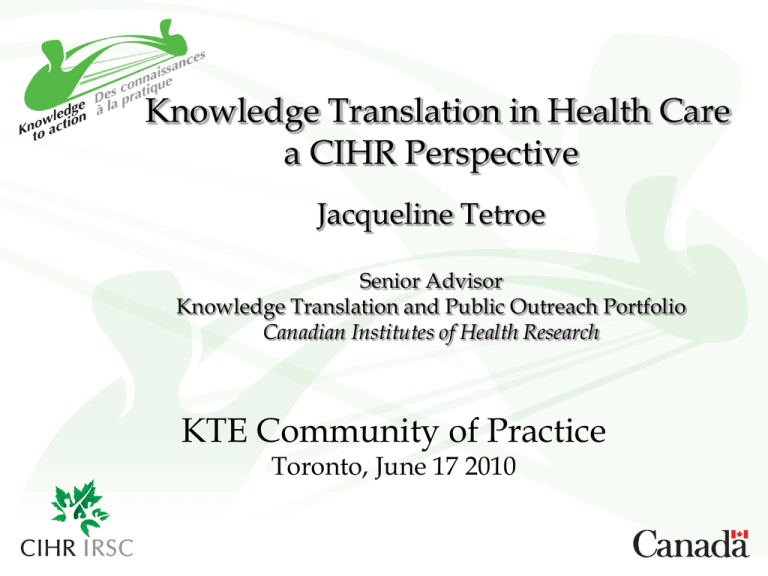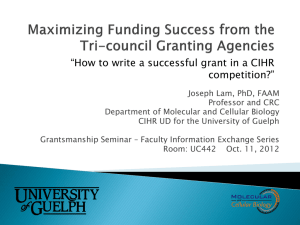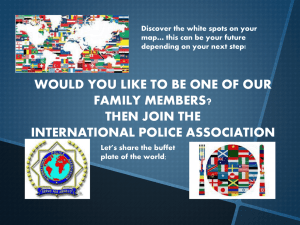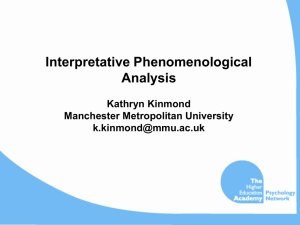Presentation slides for Jacqueline Tetroe
advertisement

Knowledge Translation in Health Care a CIHR Perspective Jacqueline Tetroe Senior Advisor Knowledge Translation and Public Outreach Portfolio Canadian Institutes of Health Research KTE Community of Practice Toronto, June 17 2010 Knowledge Translation in Health Care a CIHR Perspective • • • • • • Things I will NOT be talking about today: CIHR’s definition of knowledge translation Why KT is important Funding opportunities for KT science and practice at CIHR How to be successful in the above competitions Our partnership survey of successful researcher and knowledge-user integrated KT grant applicants Our analysis of funded and unfunded iKT grants to determine how to get more of them in the fundable range Knowledge Translation in Health Care a CIHR Perspective What I will be talking about today: • The knowledge to action cycle • Its link to the book Knowledge Translation in Health Care. Moving from Evidence to Practice Key References 1. Straus, SE, Tetroe,JM & Graham ID (Eds.)(2009), Knowledge Translation in Health Care. Moving from Evidence to Practice (pp. 185-195). Oxford: Wiley-Blackwell. 2. Graham ID, Logan, J., Harrison MB, Straus, S., Tetroe, JM, Caswell, W. et al. (2006). Lost in knowledge translation: Time for a map? Journal of Continuing Education in Health Professions, 26, 13-24. 3. Graham ID & Tetroe, JM (2010). The Knowledge to Action framework. In J.Rycroft-Malone & T. Bucknell (Eds.), Models and Frameworks for Implementing Evidence-Based Practice: Linking Evidence to Action (pp. 207-222). Oxford: Wiley-Blackwell, Sigma Theta Tau International Honor Society of Nursing. Now available from Wiley-Blackwell or Amazon.ca (discounted to $60.66!!) All royalties go into a CIHR fund for students Monitor Knowledge Use Select, Tailor, Implement Interventions Assess Barriers/ Supports to Knowledge Use from: Graham et al: Lost in Knowledge Translation: Time for a Map? KNOWLEDGE CREATION Knowledge Inquiry Synthesis Adapt Knowledge to Local Context Evaluate Outcomes Products/ Tools http://www.jcehp.com/vol26/2601graham2006.pdf Identify Problem Identify, Review, Select Knowledge Sustain Knowledge Use The knowledge to action (K2A) framework • based on a concept analysis of 31 planned action theories • was developed to help make sense of the black box known as ‘knowledge translation’ or ‘implementation’ • offers a holistic view of the phenomenon by integrating the concepts of knowledge creation and action The knowledge to action (K2A) framework assumes a systems perspective falls within the social constructivist paradigm which privileges social interaction and adaptation of research evidence that takes local context and culture into account • designed to be used by a broad range of audiences • has been widely cited: 103 in ISI Web of Knowledge, 244 in H – Harzings Publish or Perish, which picks up the grey literature • has not, as yet, been tested empirically The knowledge to action (K2A) framework: derivation • the set of 31 theories on which the framework is based, can provide more specific guidance as to what needs to be done at each phase • each theory has been broken down into its components and data abstraction sheets for each can be found at http://www.iceberg-grebeci.ohri.ca/research/kt_theories_db.html • viewed 403 times Jan-April 2010 - a lot more before then • each of the component theories is mapped onto the K2A framework • future iterations of the framework will be informed by feedback from the researchers and knowledge-users who are trying to apply it. The knowledge to action (K2A) framework More on the systems perspective. • knowledge producers and users are situated within a social system or systems that are responsive and adaptive, although not always in predictable ways. • the K2A process is considered iterative, dynamic, and complex, and the boundaries between the creation and action components are fluid and permeable. • the action phases may occur sequentially or simultaneously and the knowledge phases may influence or be drawn upon during action phases. • the cyclic nature of the process and the critical role of feedback loops are key concepts underpinning the framework The knowledge to action (K2A) framework • the framework encompasses research based as well as other forms of knowing such as contextual and experiential knowledge • both the knowledge creation and action components can be “activated” by different stakeholders and groups working independently of each other at different points in time • a key assumption underlying the framework is the importance of appropriate relationships The knowledge to action (K2A) framework • the action phases enable the framing of what needs to be done, how, and what circumstances/conditions need to be addressed when implementing change. • they are not meant to replace or override the component theories from which the phases were derived. e.g. when addressing the barriers to knowledge use, 18 of the 31 planned action theories had a construct dealing with this – some with more precision and coverage than others. • for each action phase other (non-planned action) theories (psychological, organizational, economic, sociological, educational, etc) may be relevant and useful (see, for example (Wensing et al., 2009 in ….. The K2A framework: limitations in how we drew it • our representation of the K2A cycle suggests circularity or a sequence of phases that need to be taken in order • we realize that this is not how implementation projects unfold in “real life”. • they are often chaotic, and move forward in an erratic manner with continuous course corrections as the action phases accommodate the contextual factors. • a better representation of our framework would be the probabilistic atomic model, where the action phases are like electrons around the nucleus of knowledge generation - and the contextual factors influence where a given phase might be at a specific time. = The K2A framework: limitations in how we drew it • the two dimensional, linear representation of the framework might seem to preclude the possibility that change can occur at multiple levels. • there is nothing inherent about the framework that would exclude its use at multiple levels. • Ferlie et al. confirm non-linear models of innovation spread. They argue that there is no linear flow or prescribed sequence of stages. “Indeed, flow is a radically inappropriate image to describe what are erratic, circular or abrupt processes, which may come to a full stop or go into reverse” Ferlie et al page 123 . Ferlie, E., Fitzgerald, L., Wood, M., & Hawkins, C. (2005). The nonspread of innovations: The mediating role of professionals. Academy of Management Journal, 48, 117-134. The knowledge to action (K2A) framework • The framework has become a key part of messaging about knowledge translation at CIHR since September, 2007. • It has been presented to a variety of CIHR’s stakeholders and internal staff, and has been well received in the sense that it is understandable and relatively simple, yet comprehensive. • Feedback from researchers and knowledge-users suggests that it provides a useful way of thinking about knowledge translation but more importantly, by breaking the process into manageable pieces, provides a structure and rationale for activities. The knowledge to action (K2A) framework • I see it cited and reproduced in CIHR grant applications – have yet to test its application or to analyze the fidelity of its use • the Canadian Partnerships Against Cancer (Kerner, 2009) has adapted the framework to guide their knowledge management strategy as has the Canadian Stroke Strategy and at least one CLAHRC in the UK. KT10 and KU10 had several posters using it as well. • has also been used as a framework for the KT Clearinghouse (http://ktclearinghouse.ca/), a repository of knowledge translation tools and resources The knowledge to action (K2A) framework • K2A cycle used as the organizing framework for the book: Knowledge Translation in Health Care. Moving from Evidence to Practice • FYI most of the contributing authors created PowerPoint presentations summarizing the chapters • Available by e-mailing amy.grosset@cihr-irsc.gc.ca Knowledge Translation in Health Care • not sure how many books have been sold • we get lots of positive feedback on the book– especially from people new to knowledge translation • strange but true: people actually claim to have read it chapter by chapter in weekly journal clubs Knowledge Translation in Health Care • Forward: Jonathan Lomas reprises his “Beyond the sound of one hand clapping” monograph • Introduction: K2A what it is and what it isn’t • Knowledge Creation • The K2A Cycle by each phase in the cycle • Theories and Models of knowledge to action • Knowledge Exchange • Evaluation of Knowledge to Action • Approaches to Measurement • KM and Commercialization • Ethics and Knowledge Translation Knowledge Translation in Health Care • Each chapter provides a high level overview of the field • Written by well-known and highly published and cited experts in the field • Is admittedly very clinically focussed • We hope to work on a new book with the focus on evidence-informed policy making • We hope to bring theory and a strong evidence base to bear on health issues and problems in order to improve health outcomes In theory, there is no difference between theory and practice. But in practice, there is. Yogi Berra For more information, visit our web page: http://www.cihr-irsc.gc.ca/e/29418.html http://www.cihr-irsc.gc.ca/f/29418.html jacqueline.tetroe@cihr-irsc.gc.ca Thank you









